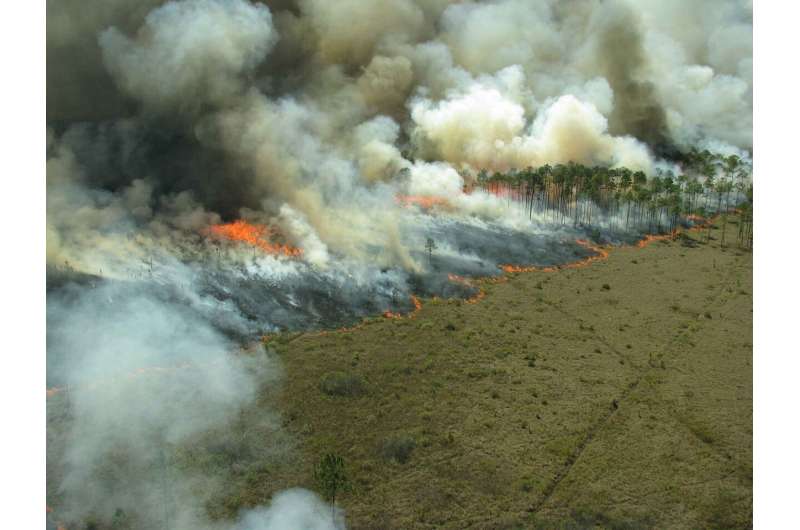This article has been reviewed according to Science X's editorial process and policies. Editors have highlighted the following attributes while ensuring the content's credibility:
fact-checked
reputable news agency
proofread
A professor studied how to make a landscape fire resilient: Then it burned

The Park Fire is the fifth-largest wildfire in the history of California, having burned about 390,000 acres and destroyed more than 400 structures. Authorities say it began when a man pushed a burning car into a ravine, and it quickly spread across a landscape covered in dry vegetation.
The fire has swept through the Big Chico Creek watershed, a 240-square-mile area in and around the City of Chico. While the city itself has been largely spared, the blaze has devastated a surrounding ecosystem familiar to Emily Schlickman, assistant professor of landscape architecture and environmental design at the University of California, Davis.
She and her students had been studying the Big Chico Creek area before it went up in flames, looking at ways to make it more resilient to wildfires—and in turn reduce the risk of a blaze spreading through the city itself.
Schlickman studies how land use planning and landscape management can support adaptation to climate change. Her students drew up plans for mixed-use developments that would build new housing in Chico's interior rather than on its fire-threatened periphery.
The city has said infill development, the practice of increasing density in already-settled areas, is a key part of meeting housing needs and had requested proposals for an area near the center of the city. The students also developed strategies to manage the landscape in ways that would mitigate the risk of an out-of-control blaze.
"It's hard to think about, but all of these strategies, in light of what has happened over the last few days, might have been helpful," Schlickman said. "Especially since the fire started right where we were working."
Schlickman spoke to Bloomberg Green about why the Park Fire has spread so rapidly, how land use can mitigate fire risk and her work in the Big Chico Creek area. This conversation has been edited and condensed for clarity.
What has made the Park Fire so devastating?
I think one thing is the weather. We have been facing a massive heat wave, and at the same time we've had two pretty wet years prior to this year. And so there's been a lot of growth in the vegetation, which has then dried out and that's actually created more fuel for the fire.
In this part of California there are a lot of canyons. It's hard terrain to fight in as a firefighter. There aren't many roads. And also a lot of the communities in that region are kind of situated on ridges, which is a really vulnerable part of the landscape.
Prior to colonization in California, so many of our landscapes looked different. We had a lot of lightning-ignited fires that were allowed to burn, but we also had a lot of Indigenous management of the landscape. After colonization, we suppressed fire, and ironically, now as a result, we have these much larger fuel loads in the forest where we have continuous vegetation.
What role does land use planning have in fire mitigation?
By promoting more development in the wildland-urban interface, we're putting more communities at risk and we're increasing the potential for more ignition. I think our current insurance landscape is mitigating this to some extent, but I think [we need to be] smart about where do we build new homes, right?
What was your experience bringing local government on board with this kind of project?
We've worked with the planning group at the city of Chico for the past couple of years. They had already identified infill development as a primary goal. Chico has had such an influx of residents and there's just such a need for housing.
Has the infill development part of the project been affected by the fire?
No, it's in the heart of the city. It's right along the creek, but the fire did not move towards downtown Chico.
What were a couple of examples of the landscape management projects?
A couple of students really looked at bolstering good burning, so prescribed burning, cultural burning, engaging local Indigenous tribes to bring more good fire on the landscape. A few of the students were really interested in thinning and weeding, and so they created [a plan for] this foraging path that also served as a fire break all along the creek, going from downtown Chico up into the foothills.
In the wake of the fire, will the landscape management work be able to continue?
Yes. I think it will. It will be a different type of project.
I think everyone is just processing what has happened, and people aren't even sure if they lost their houses or not at this point, so I think it's a little too soon to think about next steps. But I'm pretty committed to staying in this area and thinking about: What does a post-fire recovery look like?
2024 Bloomberg L.P. Distributed by Tribune Content Agency, LLC.



















